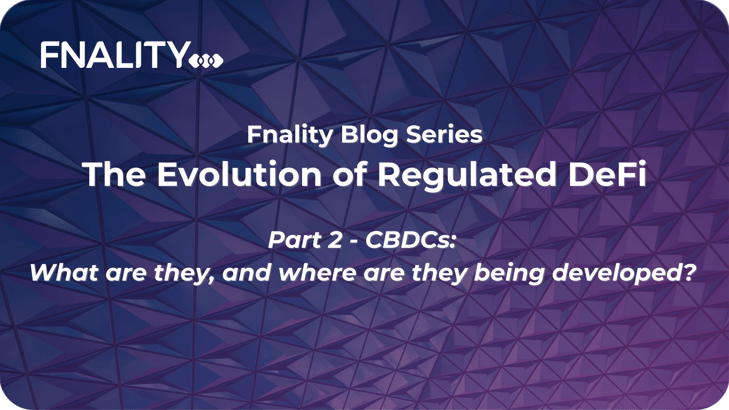
In our most recent blog post, we explored why the speed of market acceptance of stablecoins has constituted a financial stability concern for oversight authorities, one that has sped up their thinking around the need for a legal framework to regulate novel payment solutions.
Central bankers have also begun to explore alternatives to stablecoins, one particularly notable example being Central Bank Digital Currency (CBDC); a digital form of a country’s fiat currency, issued and regulated by the national central bank.
The financial authorities of around 90 countries worldwide - representing 90% of global GDP - are now exploring CBDC issuance and investigating the effect they may have on their economies, on existing financial infrastructure, and on broader financial stability.
In this blog post we review their official statements, we summarise the latest CBDC Proof of Concepts (PoCs) completed so far, and we share our view on the future of CBDCs and the growing central role of private sector initiatives like Fnality.
Major market financial authorities' statements on CBDC
- In the UK, the introduction of the Bank of England’s new omnibus account model, announced in April 2021, created an opportunity for innovative financial market infrastructures to access the Bank's RTGS system in a new way. Such a payment system's participants will be able to utilise money held at the central bank to settle wholesale payments on a 24/7 basis. The new omnibus account (OA) policy is the first strong indication that regulators understand the growing industry need for tokenised cash and assets, and that they recognise the benefits brought about by innovative technology adoption.
- On 20th January 2022, the Federal Reserve released a discussion paper that examines the pros and cons of a potential US CBDC. The Fed’s definition of CBDC limits this to assets that are 'widely available to the general public'. This implies that the concept of a Fed-led wholesale CBDC available to financial institutions is out of scope, at least initially. To fully evaluate the pros and cons of a potential CBDC, the FED seeks comment from the public on more than 20 questions.
- The EU has recently published a call for evidence from the European Securities and Markets Authority (ESMA) seeking inputs from stakeholders on the use of distributed ledger technology (DLT) for trading and settlement, and on the need for the introduction of new regulatory technical standards (RTS).
Major CBDC Proofs of Concept (PoCs) completed so far
-
Project Dunbar: a platform where multiple countries issue digital currencies on a shared blockchain: the Multi-CBDC (M-CBDC). Central banks participating in the cross-border trials are Singapore, Malaysia, Australia, South Africa, Thailand, Hong Kong, China, and the UAE.
-
Project Atom: a CBDC issued by the Reserve Bank of Australia that could be used by wholesale market participants for the funding, settlement, and repayment of a tokenised syndicated loan on an Ethereum-based DLT platform.
-
Project Jura: a trial between the central banks of France and Switzerland focusing on the cross-border settlement of foreign exchange transactions and tokenised securities. It’s worth noting that Banque de France, along the same lines of the BoE, confirmed that the tests do not have to be interpreted as a CB decision to launch a CBDC.
-
Project Helvetia: another Swiss multi-phase trial by the BIS Innovation Hub, the Swiss National Bank (SNB) and the financial infrastructure operator SIX. The project involves the settlement of tokenised securities transactions. Banks part of the test: Citi, Credit Suisse, Goldman Sachs, Hypothekarbank Lenzburg and UBS.
-
Project Delphi: a trial CBDC issued by the Oesterreichische Nationalbank (Austria) pegged directly to the Euro. The research project is currently exploring digital bond issuance with a focus on legal requirements implementing a wholesale blockchain-based solution.
-
JPM and the Central Bank of Bahrain have just completed a trial involving commercial Bank (ABC) and its client Aluminium Bahrain (ALBA) to make real-time US$ payments with U.S. counterparties that are also JP Morgan bank account holders. The aim is to speed up payments and settlement between buyers & suppliers. In a recent communication, The Bahrain central bank will be looking to extend the collaboration with JPM to CBDC.
The future of CBDCs and the role of private sector initiatives
Most CBDC discussions today focus on retail applications (see again the Fed’s definition), where the CBDC would be used as a digital version of cash.
Despite the numerous POCs, no wholesale CBDC has yet gone live: the focus of several major central banks has shifted from the pursuit of wholesale CBDC to the incorporation of features of DLT into RTGS renewal programmes.
- Recently, Andrew Bailey (BoE’s Governor) and Sir Jon Cunliffe (Deputy Governor for Financial Stability at the BoE) confirmed that they do not have plans for developing a wholesale CBDC, but that they will take advantage of private-sector innovations (official evidence here & more press info here).
The absence of any live CBDC solution might indicate that public sector institutions may eventually rely, at least partially, on solutions borne from public-private partnerships, such as Fnality. This would follow the direction already indicated by the UK with respect to its Omnibus Account Policy; the UK expects DLT type solutions to come from the private sector and to utilise the Omnibus account.
Our view is that a CBDC could be a good solution for a single currency in its’ domestic market but will require significant collaboration between jurisdictions for cross-border payments. When it comes to foreign exchange transactions (PvP), two CBDCs need to be interoperable from a technical, legal, and a risk perspective.
If different jurisdictions each developed their own CBDC, Fnality could still offer an interoperability layer that ensures atomic cross-border settlements, compatible with different CBDCs, whether on DLT platforms or centralised systems.
Coming up in Part 3 of this series:
Traditional market players are rapidly exploring opportunities in tokenisation.
What will tokenised financial markets look like? Who are the players that will be leading in this space?
Don’t miss our third and final blog post on The Evolution of Regulated DeFi!
If you’ve missed last week's blog post on stablecoins, you can find it here.


